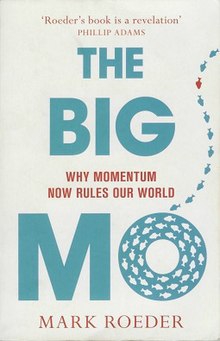
In physics, a force is an influence that can cause an object to change its velocity, i.e., to accelerate, meaning a change in speed or direction, unless counterbalanced by other forces. The concept of force makes the everyday notion of pushing or pulling mathematically precise. Because the magnitude and direction of a force are both important, force is a vector quantity. The SI unit of force is the newton (N), and force is often represented by the symbol F.

Tidal acceleration is an effect of the tidal forces between an orbiting natural satellite and the primary planet that it orbits. The acceleration causes a gradual recession of a satellite in a prograde orbit, and a corresponding slowdown of the primary's rotation. The process eventually leads to tidal locking, usually of the smaller body first, and later the larger body. The Earth–Moon system is the best-studied case.
In theoretical physics, particularly in discussions of gravitation theories, Mach's principle is the name given by Albert Einstein to an imprecise hypothesis often credited to the physicist and philosopher Ernst Mach. The hypothesis attempted to explain how rotating objects, such as gyroscopes and spinning celestial bodies, maintain a frame of reference.
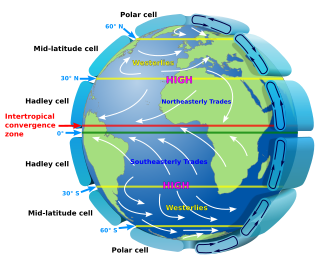
Atmospheric circulation is the large-scale movement of air and together with ocean circulation is the means by which thermal energy is redistributed on the surface of the Earth. The Earth's atmospheric circulation varies from year to year, but the large-scale structure of its circulation remains fairly constant. The smaller-scale weather systems – mid-latitude depressions, or tropical convective cells – occur chaotically, and long-range weather predictions of those cannot be made beyond ten days in practice, or a month in theory.
In astrophysics, dynamical friction or Chandrasekhar friction, sometimes called gravitational drag, is loss of momentum and kinetic energy of moving bodies through gravitational interactions with surrounding matter in space. It was first discussed in detail by Subrahmanyan Chandrasekhar in 1943.

The Newton's cradle is a device, usually made of metal, that demonstrates the principles of conservation of momentum and conservation of energy in physics with swinging spheres. When one sphere at the end is lifted and released, it strikes the stationary spheres, transmitting a pressure or sonic wave through the stationary spheres, thereby creating a force that pushes the last sphere upward. The last sphere swings back and strikes the nearly stationary spheres, repeating the effect in the opposite direction. The device is named after 17th-century English scientist Sir Isaac Newton and was designed by French scientist Edme Mariotte. It is also known as Newton's pendulum, Newton's balls, Newton's rocker or executive ball clicker.
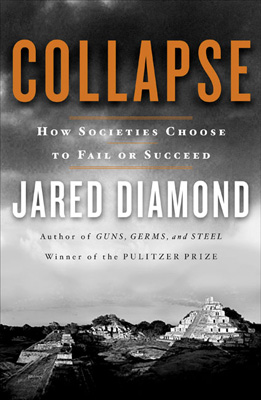
Collapse: How Societies Choose to Fail or Succeed is a 2005 book by academic and popular science author Jared Diamond, in which the author first defines collapse: "a drastic decrease in human population size and/or political/economic/social complexity, over a considerable area, for an extended time." He then reviews the causes of historical and pre-historical instances of societal collapse—particularly those involving significant influences from environmental changes, the effects of climate change, hostile neighbors, trade partners, and the society's response to the foregoing four challenges. It also considers why societies might not perceive a problem, might not decide to attempt a solution, and why an attempted solution might fail.
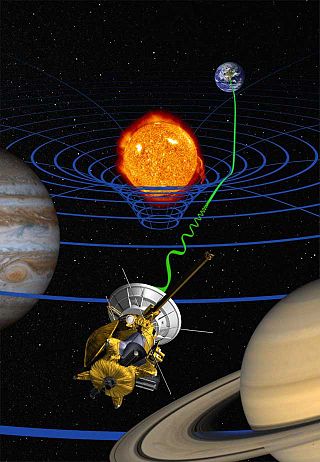
General relativity is a theory of gravitation developed by Albert Einstein between 1907 and 1915. The theory of general relativity says that the observed gravitational effect between masses results from their warping of spacetime.

Planetary migration occurs when a planet or other body in orbit around a star interacts with a disk of gas or planetesimals, resulting in the alteration of its orbital parameters, especially its semi-major axis. Planetary migration is the most likely explanation for hot Jupiters. The generally accepted theory of planet formation from a protoplanetary disk predicts that such planets cannot form so close to their stars, as there is insufficient mass at such small radii and the temperature is too high to allow the formation of rocky or icy planetesimals.

Earth's rotation or Earth's spin is the rotation of planet Earth around its own axis, as well as changes in the orientation of the rotation axis in space. Earth rotates eastward, in prograde motion. As viewed from the northern polar star Polaris, Earth turns counterclockwise.
Friction of distance is a core principle of geography that states that movement incurs some form of cost, in the form of physical effort, energy, time, and/or the expenditure of other resources, and that these costs are proportional to the distance traveled. This cost is thus a resistance against movement, analogous to the effect of friction against movement in classical mechanics. The subsequent preference for minimizing distance and its cost underlies a vast array of geographic patterns from economic agglomeration to wildlife migration, as well as many of the theories and techniques of spatial analysis, such as Tobler's first law of geography, network routing, and cost distance analysis. To a large degree, friction of distance is the primary reason why geography is relevant to many aspects of the world, although its importance has been decreasing with the development of transportation and communication technologies.

The black swan theory or theory of black swan events is a metaphor that describes an event that comes as a surprise, has a major effect, and is often inappropriately rationalized after the fact with the benefit of hindsight. The term is based on an ancient saying that presumed black swans did not exist, until they were discovered in Australia in 1697, and it then became reinterpreted to mean an unforeseen and consequential event.

The Black Swan: The Impact of the Highly Improbable is a 2007 book by Nassim Nicholas Taleb, who is a former options trader. The book focuses on the extreme impact of rare and unpredictable outlier events—and the human tendency to find simplistic explanations for these events, retrospectively. Taleb calls this the Black Swan theory.

Boundary currents are ocean currents with dynamics determined by the presence of a coastline, and fall into two distinct categories: western boundary currents and eastern boundary currents.
In astronomy, CENBOL is a model developed by the astrophysicist Sandip Chakrabarti and collaborators to explain the region of an accretion flow around a black hole.
The Big Mo is behavioral momentum that operates on a large scale. The concept originally applied to sporting events in the 1960s in the United States, as momentum appeared to have an effect on a team's performance. Successful teams were said to have "The Big Mo" on their side. This has since extended situations in which momentum is a driving factor, such as during political campaigns, social upheavals, economic cycles, and financial bubbles.

The Better Angels of Our Nature: Why Violence Has Declined is a 2011 book by Steven Pinker, in which the author argues that violence in the world has declined both in the long run and in the short run and suggests explanations as to why this has occurred. The book uses data simply documenting declining violence across time and geography. This paints a picture of massive declines in the violence of all forms, from war, to improved treatment of children. He highlights the role of nation-state monopolies on force, of commerce, of increased literacy and communication, as well as a rise in a rational problem-solving orientation as possible causes of this decline in violence. He notes that paradoxically, our impression of violence has not tracked this decline, perhaps because of increased communication, and that further decline is not inevitable, but is contingent on forces harnessing our better motivations such as empathy and increases in reason.
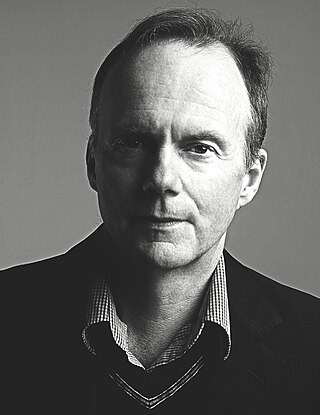
Mark Lewis Mendick Roeder is an Australian-British author and cultural commentator. He has written The Big Mo (book): Why Momentum Rules The World (2011), and Unnatural Selection: Why The Geeks Will Inherit The Earth (2013). Roeder's books and articles explore social phenomena and the impact of technology on human behaviour.

Unnatural Selection: Why The Geeks Will Inherit The Earth is a book by Mark Roeder, first published by ABC Books in 2013

Behave: The Biology of Humans at Our Best and Worst is a 2017 non-fiction book by Robert Sapolsky. It describes how various biological processes influence human behavior, on scales ranging from less than a second before an action to thousands of years before.
